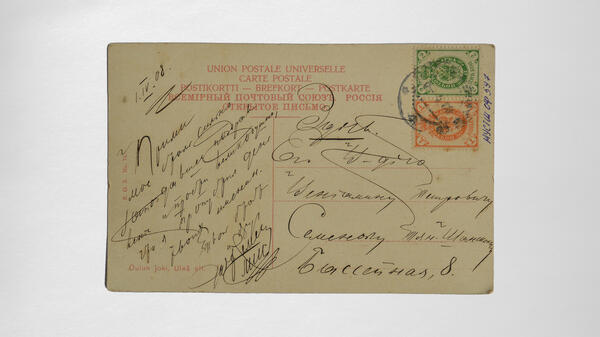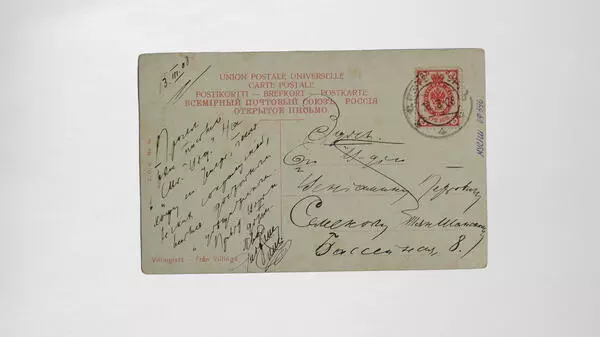A postcard from the museum collection depicts a view of the Oulujoki River in Finland. On the back there is the text: “Accept my congratulations, which are so late, and accept my sincerest apologies that I missed your birthday celebration. Your brother and friend Andrey STSh. Veniamin Petrovich Semyonov-Tyan-Shansky, 8, Basseinaya Street “.
Andrey Semyonov-Tyan-Shansky (1866-1942) was a geographer, entomologist and translator. While growing up he was greatly influenced by his father, geographer and traveler Pyotr Semyonov-Tyan-Shansky, and surrounded by his diverse scientific interests. In his youth, he became interested in entomology, the science of insects, and devoted his whole life to it.
In 1888, Andrey Semyonov-Tyan-Shansky accompanied his father on a long journey across Central Asia. The result of the trip was the publication of the scientist”s first entomological research. From 1890 until his death, he worked at the Zoological Museum of the St. Petersburg Academy of Sciences (later called the Zoological Institute).
Overall, the scientist described 900 different species and genera of beetles and published more than a thousand scientific papers. Besides, his work as Vice President of the Russian Entomological Society (as President from 1914) was extremely fruitful. Like his father, he was an outstanding person: he knew world literature well; in particular, he was a brilliant connoisseur of Latin poetry, especially Horace. Experts consider his translations to be exemplary in beauty and accuracy.
Another of his interests was the history of the navy and maritime operations. He was the chairman of the Russian Maritime Union and, after the Russo-Japanese War, published articles defending the vital need to recreate the Russian Navy in the Far East.
He contributed much to the Russian Geographical Society where in 1910 he organized a biogeographic commission. Moreover, together with his brother Veniamin he was at the origins of nature conservation in Russia and was the initiator of the creation of the Permanent Environmental Commission under the Geographical Society. Andrey Semyonov-Tyan-Shansky died in besieged Leningrad on March 7, 1942 and was buried next to his parents and sister Olga at the Smolensk Cemetery of Vasilievsky Island.
Andrey Semyonov-Tyan-Shansky (1866-1942) was a geographer, entomologist and translator. While growing up he was greatly influenced by his father, geographer and traveler Pyotr Semyonov-Tyan-Shansky, and surrounded by his diverse scientific interests. In his youth, he became interested in entomology, the science of insects, and devoted his whole life to it.
In 1888, Andrey Semyonov-Tyan-Shansky accompanied his father on a long journey across Central Asia. The result of the trip was the publication of the scientist”s first entomological research. From 1890 until his death, he worked at the Zoological Museum of the St. Petersburg Academy of Sciences (later called the Zoological Institute).
Overall, the scientist described 900 different species and genera of beetles and published more than a thousand scientific papers. Besides, his work as Vice President of the Russian Entomological Society (as President from 1914) was extremely fruitful. Like his father, he was an outstanding person: he knew world literature well; in particular, he was a brilliant connoisseur of Latin poetry, especially Horace. Experts consider his translations to be exemplary in beauty and accuracy.
Another of his interests was the history of the navy and maritime operations. He was the chairman of the Russian Maritime Union and, after the Russo-Japanese War, published articles defending the vital need to recreate the Russian Navy in the Far East.
He contributed much to the Russian Geographical Society where in 1910 he organized a biogeographic commission. Moreover, together with his brother Veniamin he was at the origins of nature conservation in Russia and was the initiator of the creation of the Permanent Environmental Commission under the Geographical Society. Andrey Semyonov-Tyan-Shansky died in besieged Leningrad on March 7, 1942 and was buried next to his parents and sister Olga at the Smolensk Cemetery of Vasilievsky Island.




